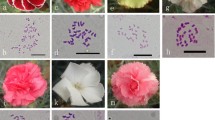Summary
A number of crosses were made between diploid and tetraploid Lolium perenne plants in order to determine the degree of cross compatibility between the two different ploidy levels. The range of hybridization undertaken involved diploidxdiploid, and tetraploid x tetraploid control crossings, diploid x tetraploid crosses, tetraploid x diploid crosses and mixed pollinations. The seed set, the germination capacity of resultant hybrid seeds, and the chromosome constitution of derived seedlings was determined. In addition attempts were made to culture 12 day-old hybrid embryos from the diploid x tetraploid and reciprocal crosses.
The crossing results obtained indicated no barrier to fertilization between diploids and tetraploids, but the irregular and poor development of the seed accompanied by much reduced germination, indicated unsatisfactory endosperm establishment of large numbers of triploids, as confirmed by the result of culturing embryos dissected from 12-day old “seeds”.
In preliminary studies undertaken to determine the extent to which diploid and tetraploid ryegrass varieties intercross when grown in close proximity for seed production, Griffiths and Pegler (1966) observed a very low incidence of triploids amongst the progenies of diploid plants exposed to the pollen of tetraploid plants and also amongst the progenies of tetraploid material exposed to the pollen of diploid plants.
In these and subsequent studies it was noted that only a very small proportion of the so-called fully formed seeds derived from diploid x tetraploid crosses did actually germinate. When, in 1964, propagules of clones of S.24 perennial ryegrass, well separated from one another, were placed in drills of the tetraploid perennial ryegrass variety Reveille, the proportion of florets which formed caryopses, and of caryopses which germinated was as follows (Table 1).
The data (Table 1) clearly indicate that a considerable proportion of the S.24 florets had been fertilized by 2n pollen and had formed caryopses, but most of these had proved to be defective. As noted in the previous studies, the frequency of triploid seedlings was low, thus suggesting incompatibility between the n and 2n gametes for the production of viable zygotes.
Of the total progenies classed as tetraploids in the early seedling stage, 80% proved to be ryegrass x tall fescue F1 hybrids. These arose as a result of free crossing with
Similar content being viewed by others
References
AlexanderD. E. & BeckettJ. B., 1963. Spontaneous triploidy and tetraploidy in maize. J. Hered. 54: 105–106.
Barclay, P. C. & Armstrong, J. M., 1966. Certain aspects of chromosome number and seed size in induced tetraploid pasture plants. Proc. 10th Int. Grassld Congress, Helsinki. p. 667–671.
BourhamontJ., 1961. Embryo culture of rice on sterile medium. Euphytica 10: 283–293.
CarrollC. P. & BorrillM., 1965. Tetraploid hybrids from crosses between diploid and tetraploid Dactylis and their significance. Genetica 36: 65–82.
CavanaghJ. A. & AlexanderD. E., 1963. Survival of tetraploid maize in mixed 2n–4n plantings. Crop Sci. 3: 329–331.
CooperD. C., 1951. Caryopsis development following matings between diploid and tetraploid strains of Zea mays. Am. J. Bot. 38: 702–708.
CooperD. C. & BrinkR. A., 1945. Seed collapse following matings between diploid and tetraploid races of Lycopersicon pimpinellifolium. Genetics 30: 376–401.
GriffithsD. J. & PeglerR. A. D., 1966. Cross fertilization between diploid and tetraploid ryegrass. J. Br. Grassld Soc. 21: 162–166.
HagbergA. & EllerstromS., 1959. The competition between diploid, tetraploid and aneuploid rye. Hereditas 45: 369–416.
HakanssonA., 1952. Seed development after 2x, 4x crosses in Galeopsis pubescens. Hereditas 38: 425–448.
HakanssonA., 1956. Seed development of Brassica oleracea and B. rapa after certain reciprocal pollinations. Hereditas 42: 373–396.
HakanssonA. & EllerstromS., 1950. Seed development after reciprocal crosses between diploid and tetraploid rye. Hereditas 36: 256–296.
HowardH. W., 1947. Seed size in crosses between diploid and autotetraploid Nasturtium officinale and allotetraploid N. uniseriatum. J. Genet. 48: 111–118.
MuntzingA., 1951. Cyto-genetic properties and practical value of tetraploid rye. Hereditas 37: 17–84.
NarayanaswamiS. & NorstogK., 1964. Plant embryo culture. Bot. Rev. 30: 587–628.
RandolphL. F., 1935. Cytogenetics of tetraploid maize. J. agric. Res. 50: 591–605.
RandolphL. F., 1941. An evaluation of induced polyploidy as a method of breeding crop plants. Am. Nat. 75: 347–363.
Author information
Authors and Affiliations
Rights and permissions
About this article
Cite this article
Griffiths, D.J., Pegler, R.A.D. & Tonguthaisri, T. Cross compatibility between diploid and tetraploid perennial ryegrass (Lolium perenne L.). Euphytica 20, 102–112 (1971). https://doi.org/10.1007/BF00146780
Received:
Issue Date:
DOI: https://doi.org/10.1007/BF00146780




